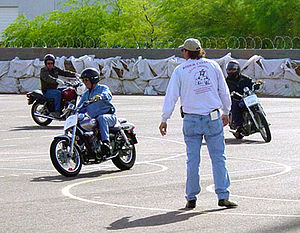Motorcycle Licence Requirements
When getting a motorcycle license, it’s important to remember that regulations for drivers changed in January 2013; the changes involve more testing, as well as alterations to the age by which you can drive certain kinds of bikes. It’s worth, then, looking in more detail at what you need to do in order to qualify for a motorcycle licence, and why it’s now harder to progress through to owning a full powered bike before the age of 24.
Before you can start applying for a motorcycle licence at the age of 17, you’ll need to complete a Compulsory Basic Training course – this also applies to driving mopeds on public roads. The CBT course covers mopeds up to an engine size of 50 cc from the age of 16, and is valid for 2 years; you won’t, however, be able to carry any passengers until you’ve completed your full motorcycle test.
Anyone who applies for a CBT will have two years in which to pass their full motorcycle test, after which time they’ll have to reapply to complete another CBT; this course is unavoidable unless you passed your driving test before 2001, and involves everything from eyesight checks to on and off road training and riding. You often complete the course with others at a dedicated training centre, after which time you’ll receive a DL196 form.
To take your full motorcycle test, you’re first have to complete a driving theory test, which is the same as one used for cars; if you have already have a theory test in date for a car driving licence, then you shouldn’t have to take it again. Since the new regulations introduced in January 2013, the driving test is broken up into three sections, which cover different sizes of motorbike.
At 17, you can take your A1 licence, which makes you able to drive bikes up 120 and 125 cc. From 19, you can take your A2 driving licence, which takes you up to 395 cc – the idea behind this staggered progression is to get you to gradually move up to more powerful vehicles. At 21, if you’ve had an A2 licence for 2 years, you can take a Full A motorcycle test, which will allow you to drive any size of motorcycle on the road. If you’re over 24, and you’ve passed your CBT test, you can move through to A2 and A categories much faster.
You will also need to get insurance and road tax for your motorcycle before you’ll be legal to drive on the road. Tax goes by engine size – below 150 cc you pay £16.00 a year; up to 400 cc you pay £36.00; up to 600 cc you pay £55; above that you pay £76.00. Your motorbike will also need a valid MOT every year, as well as insurance. Options for insurance include mandatory third party insurance, as well as third party fire and theft, and comprehensive insurance that covers everything.
Generally speaking, how much you’ll have to pay for your motorcycle insurance will depend on your age, the model of your bike, and any modifications that you make, as well as on your local area and the amount of theft that’s happened there. You can reduce your insurance premiums by agreeing to pay an excess, and by following the law when it comes to keeping to the speed limit and wearing a helmet at all times.
Obviously there are many companies which can provide motorcycle insurance such as Direct Asia and many price comparison websites such as Compare the Market whereby you can compare insurance quotes from many providers. Whilst price comparison websites can save you time and provide a rough idea of your insurance premium, I’d always recommend speaking to the company directly to discuss your individual requirements.








I have been considering getting my motorcycle license for a while now. This article has helped fill in a few gaps for me.
Thanks!